

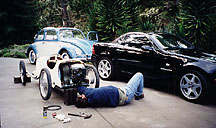 What constitutes a CycleKart? We have spent several years working on this problem, making larger and smaller machines to test what scale works best to generate the most fun while keeping seriousness to a minimum. There is a lower limit to these cars for them to retain an abstracted, romantic visual appeal; there's also a space problem for running gear, so the cars can't get too small. We've built several pedal cars and coaster cars along the same vintage lines. They're quite cute, but they lack the adult appeal of the CycleKarts.
What constitutes a CycleKart? We have spent several years working on this problem, making larger and smaller machines to test what scale works best to generate the most fun while keeping seriousness to a minimum. There is a lower limit to these cars for them to retain an abstracted, romantic visual appeal; there's also a space problem for running gear, so the cars can't get too small. We've built several pedal cars and coaster cars along the same vintage lines. They're quite cute, but they lack the adult appeal of the CycleKarts.
Conversely, if the car grows to a certain size, the driving sensation begins to approach that of a normal sports car, with all the attendant problems of venue, consequence, and a slower, more ponderous feel. After the first couple of CycleKarts, we were so excited about the fun motoring sport of these machines that we built an ever-so-slightly larger version to see if we could transfer the feel of the CycleKarts to the road: to rediscover the true essence of cyclecars. It was only marginally successful. The car is cute and fun, but lacks the carefree, zany impetuousness of the CycleKart. One has to take it slightly more seriously, and the realities of driving on the road, amongst behemoths like VW's and Honda Accords (to say nothing of SUV's and cement trucks...), behove one to at least try to have four-wheel brakes (albeit, mechanical; we didn't want to take all of the fun away). What one ends up with is pretty much what the car designers of the France and England discovered in the heyday of the cyclecar. Good fun, but a little more machine than one really needs for a CycleKart, and less-prone to being thrown around the track for a fast lap due to the consequences of the speeds required to slide about.
So...Back we are at the CycleKart: The most fun with the least machine (while still looking like a pre-war sporting machine!) This is what we've finally settled upon:
Cyclekart= A one-seat car using Honda 17"x 1 3/4" or 2" rims, 2.50 x 17" tires (2.75's have been used on the Alfa), a 38" track, wheelbase as close to 66" as the aesthetics of the car will allow (err on the shorter side for more abstract cuteness and general attractiveness), weight no more than 250lbs , and powered by a 200cc, single cylinder, 6.5 hp Honda OHV engine (the GX200). A Cyclekart should not cost more than $1750 to build in 2001 dollars (this is to avoid spending races where people start hiring out parts and making things too nice; we're not making show cars, and an element of scrounging adds to the fun).
Some measurements:
Max Length: 98"
Max Width: 40"
1"X3" steel framerails (84" long in the Type 59, rear axle 10" ahead of aft end) The 1" X 3" steel stock comes in thicker and thinner walls; we use the thinner 1/16".
Front springs 24" X 1 1/4", 2 leaf 1/2 elliptics
Amendments from January, 2022
This page was largely put together back in 2002 after the Road & Track article came out and they asked us to put up a page about Cyclekarts. Seeing as how a score of years have passed, and hundreds of cars have been built now, we think a looking-over of the "rules" is in order!
First-off, people will build what they want, and that's pretty much as we originally intended. We might want to steer the trends one way or another, or to try and get people to make better use of curves and compound shapes, but that's US, and we have NO Bearing on what people actually end up doing. Over the past two decades, we've seen some atrocious cars and many more AMAZING cars, so the average is pretty darned good! People also have been experimenting a lot — A LOT! We've come to realise that the 17" diameter wheel is The Right Size, we think, but that the hub can vary a lot depending on the original manufacturer, and sometimes the smaller hubs look great! We didn't know how they'd hold up 20 years ago, but people have been running them without problems, and that is the acid-test. We stick by the idea that you don't need a more powerful engine. We had our 26+ year-old Delage out on the main track at Laguna Seca this past November with lots of Very hopped-up engines. They could pull away on the hills, but I could stay fairly close on the flat straights — And several of those engines were having issues with their modified carburetors (as any tuned car will!), while my ancient-and-neglected stock Honda engine from '95 ran fine! We'll stick to the stock engines, thanks. Two keys -vs.- one key: I will stick to one, with the option of adding a second, if the track warrants, maybe. The more powerful engines could get away with it, but as is always the case, for me, I felt FAR more happy with the delicate, nimble feel of the Delage's steering with one key. Over the past decades, people seem to have really drifted away from the monocoque-box idea Peter and I espoused, and I still do! I think this is a mistake, but once again: People will build what they want to — and I know what I will build. Weights have crept up with fancier chassis concepts, so the 250lb limit got ignored completely. Which is fine: Their cars, their choices.
SO; Overall, not too much to amend, other than to open up the wheel-sourcing to more manufacturers. Have FUN!
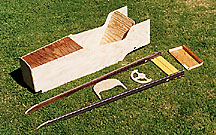 There is no lower weight limit, as we feel that this is a perfect place to "cheat". Lighter cars will perform better, but will also have better braking (using the same brakes) and the structure will be loaded less heavily: All good things. There's a natural lower weight imposed by the strength of materials used, but it would be fun to see what could be done. Lighter machines are more prone to breaking, so watch out, and keep in mind that you'll spend more time fixing things than others might. It's all part of the fun of CycleKart design.
There is no lower weight limit, as we feel that this is a perfect place to "cheat". Lighter cars will perform better, but will also have better braking (using the same brakes) and the structure will be loaded less heavily: All good things. There's a natural lower weight imposed by the strength of materials used, but it would be fun to see what could be done. Lighter machines are more prone to breaking, so watch out, and keep in mind that you'll spend more time fixing things than others might. It's all part of the fun of CycleKart design.
Some very important engineering points:
Power is transmitted via a Comet TAV-30 unit to one wheel only. Braking is also on this same rear wheel by mechanical Comet disc. NO front brakes. See the FAQ for the important reasons behind this. No rear suspension (weight gain not worth it). All of the cars have the same front and rear axle dimensions. The front axle is made up from 1 5/8" O.D. tubing, and is dropped to accommodate the leaf springs, Azusa spindles and brackets are welded on. Front axle angles are taken from an old Amilcar blueprint; they're not our own, but they work well. The steering columns and steering wheel hubs are also Azusa, lengthened to suit each car. The rear axle, drive sprocket, and hubs are also Azusa: 1" X 36" long axle, 72 tooth main sprocket, #40 chain. Front springs are buggy seat springs, half-elliptic. The fixed end has been mounted at both the front and rear ends, depending on the car. It hasn't seemed to matter which end gets the shackles. The wheels are Honda Super Cub, Passport, or Trail 90. Azusa rear wheel hubs are used on their 1" axles, and the lug bolts are ground to fit inside the Honda motorcycle hubs. New through bolts are located near the hub-reinforcing webs in the motorcycle wheels. Only one hub is keyed (the right for all our cars, and the tracks are designed with this bias in mind). Be sure to grease the freewheeling hub.
An important weakness in the drivetrain showed up after a few seasons: The Honda GX200 has a lot of torque for its size, and we're driving into a large diameter wheel. What happens is the keys in the sprocket hub and wheel hub begin to rock in the axle keyway and mess up the axle. We have now installed extra-long keys (3" or longer, with keyed locking collars on either side of the sprocket hub) in an attempt to spread the load a bit and increase the resistance to rocking. We're still testing this, but it seems like a workable solution.
The main structure of our cars is the monococque plywood box which forms the core structure. This is strong and light. The side framerails are rectangular steel tubing and are primarily for locating the axles fore-and-aft. The "exhaust pipes" on all of the cars are a necessary part of the structure; they add torsional stiffness to the box structure around the cockpit.
These are some of the methods we have used for our cars, and they have worked pretty well for us. You may find a different path for your machine. Keep in mind the concept espoused by Capt. Eddie Rickenbacker: "Anything that moves is dangerous." This is certainly true of the CycleKart, as they can inflict bodily harm in many degrees, and right quick too! Unless you're an automotive engineer who has experience with this sort of thing, don't build these. That said; these notes on how we built our cars aren't definitive, and our own cars are works-in-progress. We have no control over how other people's cars are built, nor over what sorts of materials are used in their construction. Things break and cars crash; this happens to our cars as well. As we stated before, and as we read in a set of plans we have for making a home particle accelerator using a Weber-cooker (truly, it's too bizarre to make up...): Don't Build This-For Educational Purposes Only.
We're not kidding about these being dangerous machines: every one of ours has rolled (and with no rollbars, we might add). There are NO concessions to safety on our own cars, as we don't agree with the overzealous, safety-mad modern world, but these cars are not for everyone. Once again: don't build these, as they're dangerous—just look at the pictures.
Be warned...and have fun!
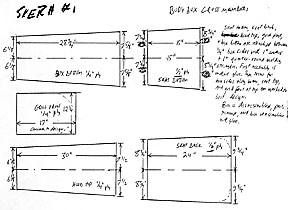 |
|||||||||||||
The Drawings... |
|||||||||||||
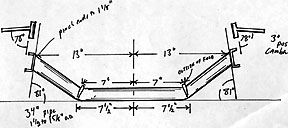 |
|||||||||||||
| The Front Axle Details | |||||||||||||
| The Body Box Details | |||||||||||||
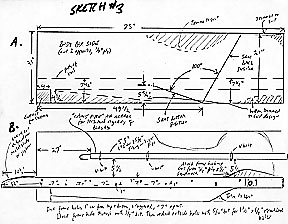 |
|||||||||||||
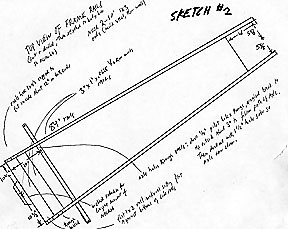 |
|||||||||||||
| A Bit of Both Frame and Body Details | |||||||||||||
| Framerail Details | |||||||||||||
The drawings above are offered more as a set of study-plans than building instructions. They're not specific blueprints to insert tab A into slot B, etc. They're notes of how some of the parts on the Type 59 are done, and a general outline of the body size. The Delage and the Mini-Magnette have different seat angles to suit their builder's tastes. All of the machines have pretty similar frame dimensions though, and you should try to stay near this size to keep the scale right.
Handmade by the indigenous peoples of Central California using natural-fiber plywood, with significant amounts of recycled material (particularly when we don't want to go to the hardware store!) No two alike!
All right: since we've had many requests from the graphologically-challenged (and the captions are a bit hard to read, we admit), here are typed notes to the above drawings. That's it: No more hints.
Copyright Stevenson Projects, LLC 2022
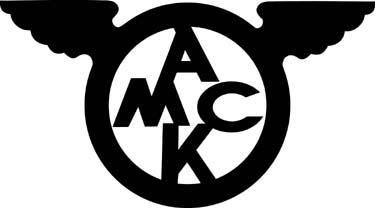 E-mail for the AMCK
E-mail for the AMCK